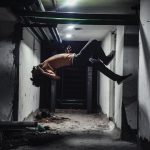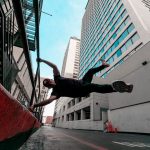Download links
How to install Mastering the Art of Parkour with taya773 APK?
1. Tap the downloaded Mastering the Art of Parkour with taya773 APK file.
2. Touch install.
3. Follow the steps on the screen.
Description
Parkour, often described as the art of movement, is a discipline that emphasizes fluidity, efficiency, and creativity in navigating obstacles. Originating in France in the late 20th century, it has evolved from a practical means of traversing urban environments into a global phenomenon that captivates enthusiasts and spectators alike. The practice involves running, jumping, climbing, and vaulting over barriers, transforming everyday landscapes into dynamic playgrounds.
Parkour is not merely about physical prowess; it embodies a philosophy of overcoming challenges and embracing one’s environment, encouraging practitioners to see the world through a lens of possibility. The roots of parkour can be traced back to the training methods of military obstacle courses, particularly those used by the French Special Forces. David Belle, one of the founders of parkour, drew inspiration from his father’s teachings on movement and agility.
As the discipline gained traction, it began to attract a diverse community of practitioners who embraced its core tenets: efficiency, adaptability, and self-expression. Today, parkour is practiced worldwide, with dedicated training spaces, competitions, and online communities that foster collaboration and innovation among enthusiasts. The allure of parkour lies not only in its physical demands but also in its ability to empower individuals to push their limits and redefine their relationship with their surroundings.
Key Takeaways
- Parkour is a physical discipline that involves moving through obstacles in a fluid and efficient manner.
- The basics of parkour include learning how to jump, climb, and balance, as well as developing spatial awareness and quick decision-making skills.
- Developing strength and agility is crucial for parkour, and can be achieved through bodyweight exercises, plyometrics, and functional training.
- Mastering parkour techniques with taya773 involves learning advanced movements such as precision jumps, wall runs, and cat leaps.
- Overcoming parkour challenges requires mental focus, perseverance, and the ability to adapt to different environments and obstacles.
Understanding the Basics of Parkour
The Foundational Skills of Parkour
The core skills of parkour include running, jumping, landing, climbing, and rolling. Each of these movements serves a specific purpose, enabling practitioners to traverse various terrains while minimizing the risk of injury.
The Importance of Mental Preparation
In addition to physical skills, understanding the mental aspects of parkour is crucial. Practitioners must cultivate a mindset that embraces risk-taking and resilience. This involves assessing obstacles not just as barriers but as opportunities for growth and self-discovery.
Overcoming Fear and Building Confidence
The mental preparation for parkour can be as demanding as the physical training itself; it requires focus, determination, and the ability to remain calm under pressure. Beginners often find themselves grappling with fear and self-doubt when faced with challenging obstacles. However, through consistent practice and gradual exposure to more complex movements, they can build confidence and develop a deeper understanding of their capabilities.
Developing Strength and Agility for Parkour

To excel in parkour, practitioners must develop a robust foundation of strength and agility. Strength training is essential for executing powerful jumps and vaults while maintaining control during landings. Exercises such as squats, lunges, and pull-ups are integral to building the necessary muscle groups used in parkour movements.
Additionally, incorporating plyometric exercises like box jumps and burpees can enhance explosive power, allowing practitioners to propel themselves over obstacles with greater ease. Agility is equally important in parkour, as it enables quick directional changes and fluid transitions between movements. Agility drills, such as ladder drills or cone sprints, can improve footwork and coordination.
Practitioners often engage in activities like dance or martial arts to further enhance their agility and body awareness. These disciplines emphasize fluid movement patterns and spatial orientation, which are vital for navigating complex environments in parkour. By combining strength training with agility exercises, individuals can create a well-rounded fitness regimen that prepares them for the diverse challenges they will encounter in their parkour journey.
Mastering Parkour Techniques with taya773
| Technique | Level |
|---|---|
| Wall Run | Advanced |
| Precision Jump | Intermediate |
| Roll | Beginner |
| Cat Leap | Intermediate |
One of the most effective ways to learn parkour techniques is through guidance from experienced practitioners or coaches. Taya773 is a notable figure in the parkour community who has made significant contributions to teaching and promoting the discipline. With a background in both parkour and movement coaching, Taya773 emphasizes the importance of mastering fundamental techniques before progressing to more advanced maneuvers.
This approach ensures that practitioners develop a solid foundation upon which they can build their skills. Taya773’s instructional style focuses on breaking down complex movements into manageable components. For example, when teaching the precision jump, Taya773 emphasizes the importance of foot placement, body positioning, and timing.
By practicing these elements separately before combining them into a full movement, learners can gain confidence and improve their execution. Additionally, Taya773 encourages students to film their practice sessions for self-analysis. This feedback loop allows practitioners to identify areas for improvement and track their progress over time.
Through this methodical approach to learning parkour techniques, individuals can cultivate a deeper understanding of their bodies and enhance their overall performance.
Overcoming Parkour Challenges
As with any physical discipline, parkour presents its own set of challenges that practitioners must learn to navigate. Fear is often one of the most significant obstacles faced by beginners; the prospect of jumping from heights or attempting complex maneuvers can be daunting. Overcoming this fear requires a combination of mental fortitude and gradual exposure to challenging situations.
Practitioners are encouraged to start small—focusing on low-level obstacles before gradually increasing the difficulty as they build confidence. In addition to fear management, physical challenges such as injuries or plateaus in progress can also hinder development in parkour. Practitioners must prioritize injury prevention through proper warm-up routines and recovery practices.
Understanding how to listen to one’s body is crucial; pushing through pain can lead to setbacks that may take weeks or months to recover from. Moreover, when faced with plateaus—periods where progress seems stagnant—practitioners are encouraged to reassess their training methods. This might involve seeking new challenges or diversifying their skill set by exploring different styles within parkour or related disciplines.
Taking Parkour to the Next Level

For those who have mastered the basics and are looking to elevate their parkour practice further, there are numerous avenues for growth. One approach is to participate in workshops or training camps led by experienced practitioners like Taya773 or other renowned figures in the community. These immersive experiences provide opportunities for intensive skill development while fostering connections with fellow enthusiasts who share similar passions.
Another way to advance in parkour is by setting specific goals that challenge one’s current abilities. This could involve mastering a particular trick or completing a challenging course within a set time frame. By establishing clear objectives, practitioners can maintain motivation and track their progress more effectively.
Additionally, engaging with the broader parkour community through social media platforms or local meetups can provide inspiration and support as individuals pursue their goals. As practitioners continue to refine their skills, they may also explore creative expression within parkour by developing their unique style or incorporating elements from other disciplines such as dance or martial arts. This fusion not only enhances personal expression but also contributes to the ongoing evolution of parkour as an art form.
Ultimately, taking parkour to the next level involves a commitment to lifelong learning and exploration within this dynamic discipline.
FAQs
What is parkour?
Parkour is a physical discipline that involves moving through an environment in a creative and efficient way, using only the human body and the surroundings to propel oneself.
Where did parkour originate?
Parkour originated in France in the 1980s, developed by David Belle and his group of friends as a way to train and move through urban environments.
What are the basic movements in parkour?
Basic movements in parkour include running, jumping, climbing, vaulting, and balancing. These movements are used to navigate obstacles and terrain in a fluid and efficient manner.
Is parkour dangerous?
Parkour can be dangerous if not practiced with proper training and safety precautions. It is important to start with basic movements and gradually progress to more advanced techniques under the guidance of a qualified instructor.
What are the benefits of practicing parkour?
Practicing parkour can improve strength, agility, coordination, and overall fitness. It also promotes problem-solving skills and mental focus, as practitioners learn to overcome physical obstacles in their environment.
Is parkour only for young and fit individuals?
Parkour can be practiced by individuals of all ages and fitness levels. It is important to start at a level that is appropriate for your abilities and progress at your own pace. Proper training and technique are key to safely practicing parkour.





